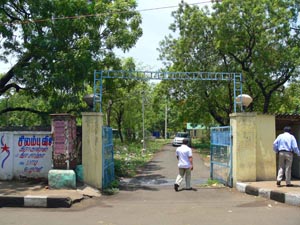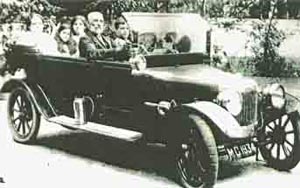|
Evelyn drives his family from Seven Wells.
If you strolled down George Town and stopped at the intersection of Old Jail Road and Mint Street, there is a long- forgotten, forlorn walled-in piece of land that seems a lifetime away from the frenetic traffic and the chaos and clutter of North Madras. This almost derelict plot, overrun with weeds and sprinkled with a couple of low buildings, was in a bygone era the only source of fresh, clean water for the citizens of old Madras, Indian and European alike. A fact remembered by fewer and fewer people as the years marched on.

Seven Wells Pump House entrance gate. |
The little neighbourhood of Seven Wells in George Town grew around the Wells that gave the place its name. The city of Madras grew with George Town as its seed, clinging to the safety and comfort of Fort St. George. And as it grew, so did its thirst for water. Today, the Wells are a distant memory, save for one lone cistern that still supplies drinking water to the Fort. It is also a little known fact that one family’s history was intrinsically entwined with the history of Seven Wells for 125 years, the Nicholas family.
My family’s tryst with Seven Wells is even older than the Wells themselves, from a time when the East India Company was still a trading house and Madras was a motley collection of villages and a small town or two.
I am a Nicholas on my mother’s side and wonderful tales of bravery and daring on the part of my ancestors have been part of our family lore for as long as I can remember. Stories passed on from generation to generation, always the same, never changing, no embellishments, told to me by my mother and her siblings, much as they were told to them by their father and his father before him.
They start with the tales of the first Nicholas to ever walk these shores. His name was Sylvester…or was it? The rumour was that he may have changed his name to hide his past, that he escaped from Ireland in a row boat, he was also rumoured to have been imprisoned in a great fort only to escape in the disguise of a sweeper with the aid of a map of the fort etched onto his thumbnail. It was said that he fought against Hyder Ali and that he was rewarded for his valour and appointed guardian of the city’s water supply and that there was a book which contained information on Sylvester and his legacy. It was in his honour that successive generations of Nicholas boys were given the middle name Sylvester, lest we forget. This can be attested by a simple walk through the south-eastern corner of St. Roque’s cemetery, where an entire section of the graveyard is host to scores of Nicholas graves, many of which bear the middle name Sylvester. The graves are so numerous that the area is affectionately called ‘Nicholas Square’! Our family worshipped at St. Mary’s Co-Cathedral in Armenian Street and later at St. Francis Xavier’s, but every Nicholas was buried in Nicholas Square. It is a family tradition to this day.
But growing older I realised that the legends of the Nicholas family were only oral, with no written proof, no dates, nothing to say these things really happened. It was also a painful realisation that my mother and her siblings were the last generation of big families, with no more large family gatherings to tell tales, to enthral the children, to carry on the Nicholas tradition. A few years ago, at a funeral, it was clear that with my grandparents’ generation dying out, now was the last chance to trace our roots and find out the facts.
The search began with writing down every name, every relation and every date possible, especially those in St. Roque’s cemetery, the internet and church records. It was at this time that the chronicler of Madras, the Editor of this journal, guided me to two books. One was a book my family knew of, A Book of South India by J.C. Molony, which described the circumstances under which Sylvester earned the appointment. It also stated that the appointment was made to the Nicholas family for 125 years. Muthiah also referred me to Vestiges of Old Madras (Vol. III) by H.D. Love which clearly lists the Superintendents in order and relation to each other. Surprisingly, it records that a Nicholas whose first name was not known was the first Superintendent and was succeeded by his nephew Sylvester Nicholas! The church records clearly stated that Sylvester was born in 1795, so it became evident that he could not have been around in 1769 when Hyder Ali raided Madras.
Unable to confirm who this new Nicholas was, during my search for records on the internet, I noticed that some of the information regarding my family posted was by a Nigel Nicholas, who turned out to be a long-lost distant cousin in London. His family was in possession of a list of every Nicholas who held the post of Superintendent of the Seven Wells Waterworks. What was surprising was that his list credited a John Nicholas as being the first Superintendent to be succeeded by his four sons, Peter, Gilbert, Hammond and John Jr. His next successor was Sylvester and the successive names on the list were in perfect chronological order with exact dates of succession. This tied in perfectly with the information in Vestiges, so then the Nigel’s list had to be a fact.
Over the past four years, records (baptism, marriage or burial) from St. Mary’s Church in Fort St. George and St. Mary’s Co-Cathedral in Armenian Street have provided corroborative evidence that the appointment to the Nicholas family was indeed hierarchical, as successive generations of Nicholas men, from Sylvester to his son Joseph and then his sons Edmond Alban Sylvester and Evelyn, were Superintendents of the Seven Wells Waterworks. The appointment ceased in 1925, with Evelyn Nicholas being the only Nicholas to relinquish his post to the Public Works Department, as every Nicholas before him had died in office.
The saga of the Nicholas family in Madras, thus, began with John Nicholas, the first of my ancestors, to set foot on our shores. Legend has it that he escaped from Ireland and set course for India, though it is unclear as to who or what he was running from. However, we have found records that refer to him as ‘Rebel’ Nicholas, a strange nickname and perhaps a fitting one, as even Vestiges of Old Madras refers to him as one whose Christian name had not been ascertained. He served in the 102nd Madras European Regiment at the time when Hyder Ali decided to show the British that he was unafraid of them, by launching raids on Madras in 1767 and again in 1769.

Evelyn drives his family from Seven Wells. |
It is even more mysterious that one of the Nicholas family legends is about a sword said to have been handed down from John Nicholas himself. This peculiar sword is called a katar, or punch dagger, with a kind of a split double handle that had the engraving of a tiger-head on the wrist guard. The katar was not a battlefield weapon; rather, it was a punch dagger used in assassination (thrust and kill), often from behind the victim and designed to kill with a single thrust.
The fact that such a weapon was handed down from John Nicholas led me to contact Robert Elgood, the world’s leading expert on ancient Indian arms, to find out how such a weapon came to be in our possession. He concurred that John Nicholas must have been posted at one of the tanks as a sentry at the time Hyder Ali had plans to poison the water supply using animal carcasses under the cover of night. That John Nicholas possibly killed his would-be assassin and claimed his weapon as ‘spoils of war’. That he raised the alarm causing Hyder Ali to abandon his plan, thus saving the British from an embarrassing defeat, as well as the citizens of Madras from being poisoned. That this act of valour and great historical importance led him to be rewarded with the appointment of ‘Guardian of the Seven Wells’ in 1800.
The Seven Wells themselves were a series of wells that were sunk by Capt. George Baker three years after Hyder’s raids, to ensure the security of the garrison stationed in Fort St. George as well as to supply fresh water to ships that docked in Madras. The Seven Wells also supplied water to Black Town and White Town and was the first piped water supply scheme in British India. Though the official title was ‘Superintendent of the Seven Wells Waterworks’, the Nicholas family was also called Guardians, Custodians and Keepers, thus emphasising the family’s close ties with the Seven Wells long after the threat of Hyder Ali and Tippu Sultan had abated.
The Nicholas family over the centuries has entrenched itself firmly in Madras, but in the past century some have dispersed across the continents, but almost every single branch of the family tree still remembers our ancestry with great pride and honour. In Madras, nine successive generations of Nicholas descendants from the mid-1700s have come to call this city their home. We still talk of the Seven Wells with which our history is forever entwined. To us, this is still hallowed ground.
|